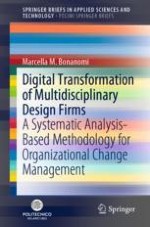
2019 | OriginalPaper | Chapter
1. Digital Transformation Trends: Toward New Forms of Process and Organization
Author : Marcella M. Bonanomi
Published in: Digital Transformation of Multidisciplinary Design Firms
Publisher: Springer International Publishing
Activate our intelligent search to find suitable subject content or patents.
Select sections of text to find matching patents with Artificial Intelligence. powered by
Select sections of text to find additional relevant content using AI-assisted search. powered by